#only butterflies and ladybugs and earthworms
Note
are there any bugs that eat mostly fungi?
very many! some have it in their names, like fungus gnats (six families, ~10,000 spp.), pleasing fungus beetles (Erotylidae) and handsome fungus beetles (Endomychidae). but many other types of beetles and flies feed on fungi, including things you might not expect, like certain ladybug beetles. some ants also eat fungi, some harvesting it directly, and others, namely leafcutter ants, by farming it on chopped plant matter. many moths and butterflies also feed on fungi as larvae—many of them on lichens, but also a few that feed on mushrooms or other fungal fruiting bodies. webspinners, barklice, and other tree trunk dwellers also often feed on lichens.
while detritivorous generalists like isopods, millipedes, and cockroaches (including termites) are known for their ability to eat decaying wood, it’s often the fungus within the wood that makes it edible. these groups also will gladly snack on fungi that grow out of the wood, and some among them are highly specialized to feed on only fungi (like siphonophorid and platydesmid millipedes).
among the smaller creatures, there are many mites and springtails that feed on fungi, including molds, mushrooms, and yeasts. other detritivores including slugs, snails, and earthworms eat fungi, with a varying degree of dependence upon it… so yes, a lot of bugs eat fungi!
87 notes
·
View notes
Text
the party and bugs
Lucas, Mike and Will all hate spiders. Spiders can go fucking die in a hole. (One time Mike jumped into Will's arms and Will jumped on top of a table where Lucas had already taken refuge and they all just huddled there and waited for Dustin to come back with a shoe.)
But Will likes all other bugs that aren't spiders
Lucas hates cockroaches and spiders, but other than that, he finds bugs pretty cool. (He's afraid of snakes though)
Mike just hates bugs. And he's a huge baby about it too (he just like me fr)
El, Max, and Dustin are all just fine with bugs
Max will kill them if they're inside her house
But El always insists on capturing them and setting them free outside
And when Elumax lives together that just melts Lucas and Max's hearts. Even when it's a spider, and Lucas looks at the thing like it murdered his grandmother, if El insists on taking it outside (which she always does) Lucas and Max let her.
El's favorite bug is a ladybug. She always makes wishes on them and counts their spots and all that fun shit
Dustin's favorite bug is a praying mantis. He says they're "badass" and he's not wrong
One time El found a stick bug and Dustin found a leaf bug and they built a tiny arena and tried to pit them against each other
Max doesn't really have a "favorite bug" persay, but she does like caterpillars. She says it's because they're small and squishy looking, but really it's something about these small, wrinkly, gross creatures going through a ton of shit and coming out of it as a beautiful butterfly and everyone knows why she loves caterpillars but no one says it
Will's favorite bug is a moth. They're very soft and they're attracted to the light, which Mike finds super annoying, especially when the lights are making buzzing noises all night during the summer and they're outside, but Will finds it endearing. Something about them being able to blend in but also having this instinct to find the light (idk where that fondness could've come from /s)
Lucas's favorite bug is an ant. They're so small but they're so strong at the same time. Even though they seem insignificant, they are still capable of amazing things. One time, he admitted this to Max and El, and Max made fun of him for being a sap, but El interjected saying, "I think that is very sweet." and Max immediately cut it out and pressed a kiss to his cheek "It's sweet, sure. But you're still a sap, stalker."
Mike pretty much runs away screaming whenever anyone goes near him with any bug. When they were younger, Lucas, Dustin, and Will used to team up after it rained, each of them grabbing a handful of earthworms and chasing him around with them. Will was usually the first one to call off the chase, but not before he slipped a worm onto Mike's pants or jacket.
The one bug that Mike will bear is a snail, and only because of the shell. He hates slugs, because they're slimy. He only likes snails because the party will sometimes just grab a bunch of snails and lay on their stomachs on the grass or the patio and just race them. Set them down and watch them go.
#byler#partycule#elmax#elumax#lumax#hopclair#el hopper#will byers#dustin henderson#mike wheeler#henderhop#headcanons#st#stranger things#st headcanons#lucas sinclair#max mayfield#wheelclair#byclair#bywheelclair#riv rambles#god i love this <3
249 notes
·
View notes
Text
Twenty-five years ago, Heckscher was a wildlife biologist with the State of Delaware’s Natural Heritage and Endangered Species Program, managing the state’s rarest species. One project had him searching for the Bethany Beach firefly, which hadn’t been seen since 1968. Was the firefly extinct, falling to one or all of the hazards threatening fireflies throughout the world, such as habitat loss, light pollution and climate change? Or had it simply gone unnoticed for 30 years? The scientific species description gave few hints, only that it had been found in Bethany Beach, Delaware. Frank Alexander McDermott, a researcher who wrote dozens of articles on fireflies, published the first paper about it in 1953. James E. Lloyd, a professor at the University of Florida known as the “Firefly Doc,” had been the last to see it.
Fireflies, known as lightning bugs in the South and Midwest, are neither flies nor bugs. Scientists save the word “bug” for a specific kind of insect with sucking mouthparts—a definition that excludes ants, butterflies and beetles. Fireflies are beetles—magical, but still six-legged insects.
Adult fireflies use their glow as “a love song in light,” as Tennessee-based firefly expert Lynn Faust puts it. A male will flash his signal, and a female will flash a response when she recognizes one of her own species. The females of a few firefly species Heckscher studies can also manipulate their flashes to lure fireflies from other species, which they then eat. In firefly larvae, the glow warns predators of toxic chemical defenses, much as the red of a ladybug or the orange of a monarch butterfly does.
A number of land creatures make light from chemicals, including various fungi, earthworms, millipedes and fungus gnats, Lewis writes. But beetles are the champion, with about 2,500 different species that make light, most of them fireflies. Their glow comes from an abdominal organ called the lantern. Inside that organ, oxygen interacts with a small, energy-packed molecule called luciferin. Some scientists believe fireflies create their pulsating patterns by regulating the flow of air.
There are at least 2,200 firefly species around the globe. Each has a glowing larval (immature) form. These larvae eat snails, slugs and worms, punching way above their weight in the web of life. But not all firefly species have adults that glow. Roughly 60 to 75 percent do, according to Oliver Keller, a biologist with the Florida Department of Agriculture and Consumer Services, who is putting together a checklist of the world’s firefly species. These species are mostly found in Asia and in North America, east of the Rocky Mountains. Fireflies thrive where the air and the ground are moist, and the American West is generally too dry for their taste.
The remaining firefly species are “dark” fireflies. They glow in their juvenile forms, and often as eggs, but not as adults. Instead, these adults find each other through scent-like pheromones, which they detect with elaborate antennae. These fireflies lack the lantern organ that fireflies use to flash. (There are also intermediate species that have both a tiny light organ and elaborate antennae to detect pheromones.) In some other species, the female firefly emits a weak, steady glow but does not fly. She merely crawls to the top of a blade of grass or, perhaps, up a tree trunk.
The adult Bethany Beach firefly Heckscher was searching for both flashed and flew. Although some believed the species was extinct, Heckscher had a hunch that it was hiding in an overlooked wetland. He narrowed the search by studying 50-year-old aerial photographs. Between the sand dunes away from the ocean, fresh water pooled, and grasses and shrubs grew. Heckscher went to one of these wetlands and quickly netted the long-missing firefly. Scientists have since found the species in a handful of these tiny wetlands studding a 27-mile-long ribbon of Atlantic coast in Delaware and Maryland.
It was the first in a string of remarkable discoveries. In 2004, Heckscher found a firefly he couldn’t identify rising from the moss near a river feeding into Delaware Bay. He thought it was just an oddball individual until he found one just like it near a river on the other side of the state in the Chesapeake Bay watershed.
He had discovered a new species of firefly. He gave it the scientific name Photuris mysticalampas. (Informally, it’s known as the mystic or mysterious lantern firefly.)
Heckscher has been searching for elusive fireflies ever since, and finding them inspires awe. Once, he searched for mystic lantern fireflies in a cedar swamp on a hot, humid night. Distant lightning lit the swamp in a pink haze. Trees and ferns flashed suddenly from the darkness, bathed in pink light, studded by the yellow-green glow of fireflies.
3 notes
·
View notes
Text
Gardening with Kids: Fun and Educational Activities for Young Gardeners
Gardening is a wonderful way to engage kids with nature and help them develop important life skills. Not only does it provide a hands-on experience, but it also offers numerous educational opportunities. Gardening can teach children about the natural world, plant life cycles, responsibility, and patience. In this blog, we will explore some fun and educational activities that will make gardening an exciting adventure for young gardeners.
Create a Kid-Friendly Garden Space: Designate a dedicated area in your yard or use containers to create a kid-friendly garden space. Make sure it's easily accessible and provides enough room for kids to move around and explore. Consider installing a raised garden bed or using colorful planters to make it visually appealing and engaging for children.
Start with Simple Plants: Choose plants that are easy to grow and maintain, such as sunflowers, cherry tomatoes, or herbs like basil and mint. These plants tend to grow quickly, providing a sense of accomplishment for young gardeners. Involve your children in the plant selection process to make them feel more invested in their garden.
Plant Seeds and Watch Them Grow: Planting seeds is a great way to introduce kids to the concept of plant life cycles. Let them choose their favorite vegetables, flowers, or herbs, and guide them through the process of planting seeds. Discuss the importance of sunlight, water, and soil for germination. Encourage them to observe and document the growth progress with drawings or a gardening journal.
Learn About Soil and Composting: Teach children about the different types of soil and explain how plants obtain nutrients from it. Take them on a mini soil exploration adventure, where they can dig, touch, and smell different types of soil. Discuss the importance of composting and involve them in creating a compost bin. Teach them how to compost kitchen scraps and garden waste to make nutrient-rich compost for their plants.
Bug Hunts and Beneficial Insects: Children are naturally curious about insects. Organize bug hunts in the garden and let them observe the different insects they find. Teach them about the roles insects play in the garden ecosystem and the difference between pests and beneficial insects. Explain how ladybugs, bees, and butterflies help with pollination and how earthworms enrich the soil.
Garden Art and Crafts: Combine creativity with gardening by incorporating garden art and crafts. Encourage kids to paint and decorate their own plant labels or create colorful garden signs. They can also make garden-themed artwork using leaves, flowers, or natural materials found in the garden. Display their artwork in the garden to make it a vibrant and personalized space.
Harvest and Cook: One of the most rewarding aspects of gardening is harvesting and enjoying the fruits (and vegetables) of your labor. Involve kids in the harvesting process and let them help prepare a simple recipe using the harvested produce. This will give them a sense of accomplishment and an opportunity to learn about healthy eating habits.
Share the Garden's Bounty: Teach children the value of sharing by encouraging them to donate extra produce or flowers from the garden to neighbors, friends, or local community centers. This will instill a sense of generosity and community spirit.

0 notes
Text
pests won't rest
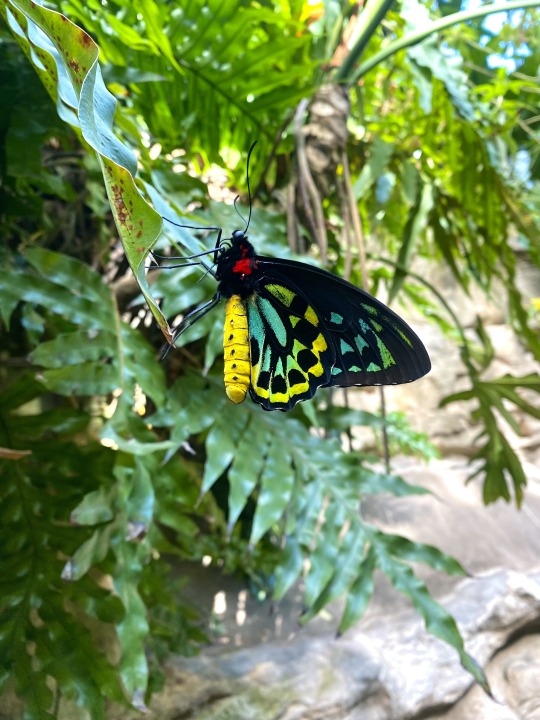
Male Green Birdwing (Ornithoptera priamus)
Pest control is one of the more challenging aspects of horticulture, especially when done ecologically responsibly. As discussed in my first pest control post, the museum tries to use the least amount of pesticides and insecticides possible.
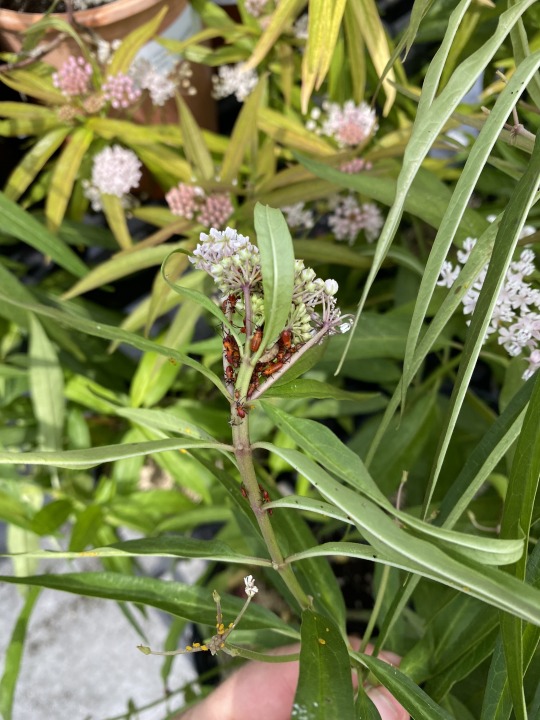
Milkweed bugs swarming an Aquatic Milkweed (Asclepias perennis).
The primary pest control method within the rainforest conservatory is through beneficial insects. Mealybugs are the most significant culprit and one of the more challenging to treat. If an infestation is caught fast enough, it can be treated with isopropyl alcohol. The alcohol essentially melts the bugs, and then they can be sprayed off with water. This process may be repeated a few times before the infestation is completely eradicated.


Zamia spp. recovering after a heavy scale and mealy bug infestation.
Scale is another very common pest. The plant above had a particularly nasty scale and mealy bug infestation. To treat this fragile plant, I slowly removed the pests using a toothbrush and soapy water. After a few weeks of recovery, the plant quickly grew two new fronds. The only remaining damage is some scarring on the undersides of the leaves.
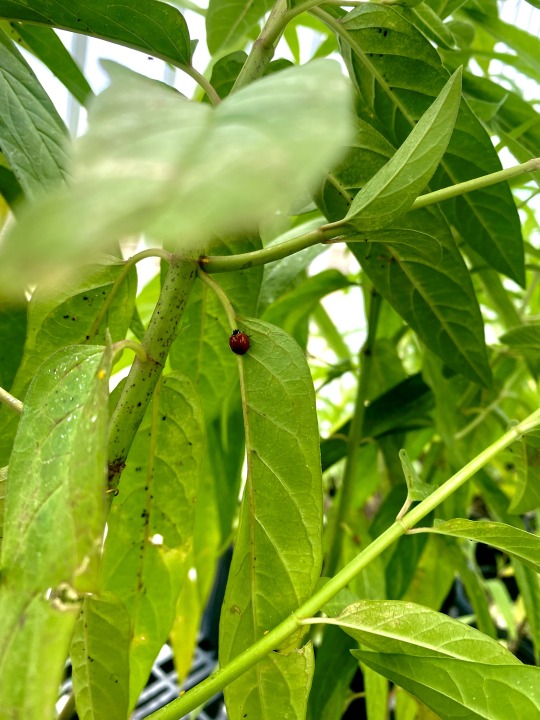
Ladybug eating aphids off of milkweed.
The preferred way to deal with pests is through beneficial insects. Twice throughout the summer, we released a few hundred Cryptolamus inside the conservatory. These beneficial insects will target mealybugs, and once released, they get to work quickly. In the greenhouses, we allow beneficials to come naturally. Ladybugs and syrphid flies are the most common and easily recognizable beneficials. On occasion, we may use insecticides within the greenhouse. This is not ideal, but not as difficult to do as in the rainforest. Because of the butterflies in the conservatory, pesticides need to target pests but are ineffective on the butterflies and other beneficial soft-bodied bugs, like earthworms.

Two Blue Porterweeds (Stachytarpheta jamaicensis) suffering from a heavy mealy bug infestation.
As you can tell from the pictures above, pests can quickly kill a plant. These Porterweeds were happy and healthy the night before this picture was taken. The mealybugs reproduced quickly and killed these plants. These plants were treated with isopropyl; however, this proved ineffective due to the severity of the infestation.
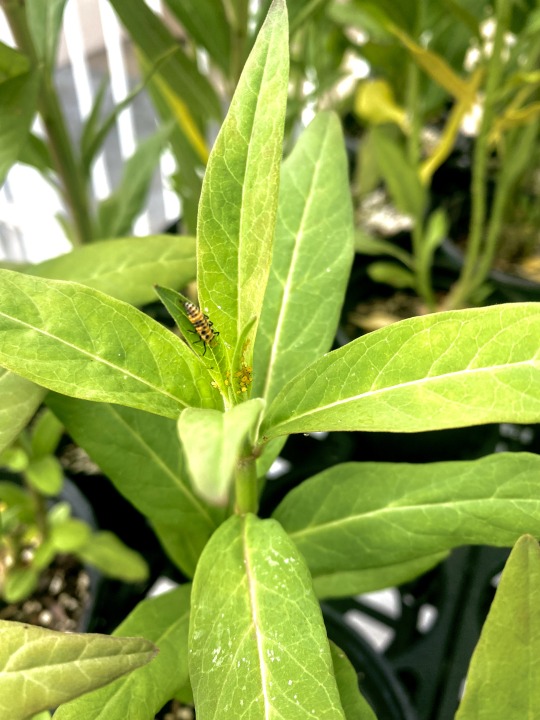
Lady bug larvae feeding on aphids on milkweed.


Freshly painted Pentas graffiti in the meadow of the rainforest.
Unfortunately, there is no way to save a plant, and the entire plant must be removed to prevent the further spread of the pests. Papaya trees are magnets for pests, and though the plant itself was surviving, the tree had to be removed for the health of the surrounding plants. The Blue Porterweeds pictured above had to be removed as well because there was no way to rehabilitate the plants. Once removed, we replanted with healthier, more resistant plants. The Pentas pictured above were planted because of their pest resistance. Pest control can be difficult, but learning how to do so in an ecologically responsible way is vital to protect beneficial insects and soil health.
0 notes
Note
hello, would you mind if you tag your posts that include bugs?
oh sure! i don’t usually reblog them, but i will keep that in mind
if you can, do you mean all bugs, or spiders?
i found the one im assuming is the issue, and i tagged it bug, bugs, insect,insects ^^
please forgive me if i forget in the future, i will make an attempt to remember, but i dont think i reblog that many bugs so it may slip my mind
but never hesitate to ask!! i’m happy to tag whatever i can uvu
#ask#anonymous#i remember once some one had an issue wit hanimitronics so i try either not to reblog that or tag them when i do#so it's no big issue as long as people ask politely#and also remember i may legit just forget#but i probably shoudnt cuz i too do not usually like bugs#only butterflies and ladybugs and earthworms#and some catapillars#Anonymous
0 notes
Photo

TALKIN’ BOUT MORE BUGSNAX
It’s true! I kept my promise this time, and it is time for the sequel to our Bugsnax post on this Flavor Friday! I got all the background information and gushing out of the way in that post, so I’ll have lots of room here to talk about even MORE than last time!

RAZZBY
You may think this is starting too familiarly... but this is not Strabby! Razzby is a raspberry, of course! Which, if you ask me, are better than strawberries. It may behave just like Strabby, but it is its own distinct creature that even has its own voice. And even though it is so similar, is that a bad thing? I don’t think so! If “recolor” creatures were left out, that would just mean fewer creatures, and more creatures means more fun! Unless it’s like, something like Yo-Kai Watch with recolors that only exist to be rewards from horrendous RNG, but that is not the case here!
Like Strabby, Razzby is said to be based on a ladybug, but the raspberry style brings even more to mind! For example, the cochineal (photo here!), a scale insect that parasitizes cactuses. The wingless females are red and lumpy enough to quite resemble a raspberry! There is also the springtail Rambutanura hunanensis (photo here!) which really looks just like a raspberry with legs and antennae. This species was discovered in 2018... after Bugsnax was well into its development! Hmmmmm!
Finally, I would like to add one more tidbit: it has recently been revealed that Strabby (and by extension, presumably Razzby) is also based on aphids! Isn’t it beautiful? Ladybugs and aphids putting aside their conflict for a greater good (a funny walking strawberry).

ROOTLE
After writing a surprisingly massive amount about Razzby, it is time to get back to my favorites! LOOK at Rootle! I was going to say “don’t you just love Rootle?” but I don’t need to. You just love Rootle! A carrot earthworm is simply splendid, especially when you actually see it moving. It stretches and contracts just like a worm! This carrot is soft, and I think it is great how strange that is. Also, Rootle is shy! If you get too close, it will burrow into the ground, with just its little rear sticking out! Please be nice around it.

SHISHKABUG
oh MAN! Shishkabug is so perfect! Cinnasnail and Rootle are perfect, but their “bug” bases are ultimately rather simple shapes. Shishkabug, however, uses only existing properties of its snak to create the comparatively complex shape of an ant! And as if that wasn’t enough? Its tomato leaves give it a polite little hairdo. And if THAT wasn’t enough either? It has perhaps the best name in the game. WOW! Shishkabug is so wonderful.

PINKLE
Pinkle has some incredibly fascinating anatomy in a way you would perhaps not expect! Normally, the pickle jar serves as its main body, and is where the eyes are attached, as four floaty pickles serve as legs. However! In order to catch it, its shell must be removed...

...and Pinkle’s anatomy changes accordingly! One pickle now becomes the main body while the other three remain as legs, now positioned differently, and the eyes move to the main pickle body. That’s so neat! I love Pinkle! At first I was unsure how to feel because it doesn’t initially resemble its hermit crab basis, but seeing its behavior and hearing its voice makes me love it a lot.

Pinkle is also used by Filbo to make Snakwater. Would you try it? It’s bug-infused!

PEELBUG
All I’m doing in this post is saying how perfect these Bugsnax are and I’m not stopping now! Peelbugs are a group of citrus fruits that behave like pillbugs! Another Snak that is perfect not only in name, but in function! Oranges are already weirdly “pre-sliced”, and Peelbugs can crawl around in this form, but they prefer to roll up into a full fruit and hide in tunnels!

FLUTTERJAM
This will be the last Bugsnak for today’s post, but I wanted to end with a REALLY wacky one! Flutterjam is one of the relatively few fully unique Bugsnax not revealed before release, and WOW! I was really amazed when I saw it. I thought I had seen it all, and then I see THIS! Not in game, mind you. I couldn’t resist. I just had to look through the iMessage sticker pack to see them all early.
Flutterjam is butterfly-based, but in a weird, uncommon way, as you can see! This sliced slice of bread is really nothing but a pair of wings, with its eyes positioned pretty far apart on those wings, not making any effort to imply a “main body!” Perhaps they even represent fake eyespots as well!
Flutterjam’s method of capture is as wacky as it deserves! You may be thinking a piece of bread with nothing but jelly on it is a strange Bugsnak basis, but the truth is, Flutterjam longs for peanut butter! It flies high above, but if you sling peanut butter at it, it will close right up and fall, happy to have realized its destiny.
That is all for now! Join us next time for even MORE!
126 notes
·
View notes
Text
On a similar topic relating to flies, there a whole swarm of big flies that are always outside my door in the gangway. I tried opening my door really fast and surprising them with Raid but while it probably kills some of them, it doesn’t completely eradicate them. I bought some fly ribbons and hung those up but they’re only catch fruit flies. I think these fatass chungus flies are either too smart and are actively avoiding the ribbons or are too strong and are able to escape the sticky trap but I’m getting really fucking fed up with these flies hanging out outside my door all day. I just think it’s unfair that all these species of bugs like butterflies, ladybugs, earthworms, and lightning bugs are becoming endangered but these fucking flies and mosquitoes are still thriving. Of course it’s the bugs everybody hates that stick around.
7 notes
·
View notes
Text
Varieties of beneficial or bad bugs for your garden
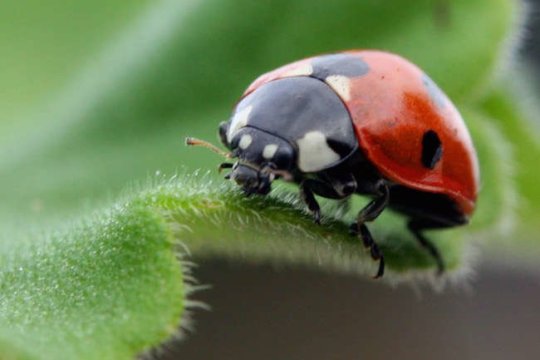
Garden is a place of our house where we can spend our free time and decorate our home with plants and flowers. Garden of our house is same as our friend, and it is a mirror of the home. Now we will discuss garden insects. Maintain your healthy garden it's important to learn about the bugs. A garden is a place where bugs come. When you spend your time in the backyard, you will see their many types of bugs. Here with the help of professional gardening company in Melbourne, we create a list of bugs that every gardener must familiar with. But before checking out the list, let’s come to know about the bugs.
Garden insects are natural, and they come in the garden without any invitation. Bugs come in the yard when blooming flowers, plants and herbs are attracting them with sweet nectar. There are many friendly bugs, and bad bugs are involved in our garden. Friendly bugs are essential for our garden that can preserve our garden from many diseases. Some bugs are beneficial for organic compost. Natural bugs keep your garden brilliant and healthy. They make the garden soil nutrient and fertilizer. Some good bugs are eating the bad bugs and protect our garden from their attack. Beneficial insects also called helper of the backyard.
Bad bugs are that which eats the leaves of flowers and plants. They destroy our garden day today. Some bad bugs attack the beneficial bugs and eat them. So, lets check out the list of some good and bad bugs:
Now we will discuss beneficial bugs of the garden. There are many useful bugs for our garden as below:
Green Lacewings larvae: It is a beautiful species feed on nectar flowers, pollen, and honeydew. It's nicknamed "aphid lions." Lacewings larvae hunt for soft prey especially aphids, mealy bugs, mites and Lepidoptera eggs. Some adult’s lacewings supplement the diet with pollen or honeydew. They eat them with their curved, pointed mandibles victims. Most of the lacewings larvae have copper-colored eyes some lacewings green in body and wing color some larvae have transparent wings, and they look open. They have also chewing mouthparts and have long filiform antennae.
The life cycle of lacewings larvae undergoes complete with four life stages: egg, larva, pupa, and adult. Mostly grown larvae will live for 4 -6 months. The female lacewing produces thin stalk, which it usually attaches to the underside of a leaf. A female worm places an egg at the end of the stalk. Some larvae lay their eggs in the group and some are laid their eggs singly. Green lacewings may be found in herbs, flowers, and grassy areas.

Lady beetles: everyone knows about the ladybug, but gardener loves it very much because of lady beetle is the good friend of the garden. It has dome-shaped back and flat underside. It displays bold colors and markings, red, orange, or yellow with black spot. It has small legs that tuck under the body. Mouth parts of the ladybirds always hidden beneath a large pronotum and mouth parts are also for chewing. Diets of the ladybugs are predators with ravenous appetites for aphids and soft-bodied insects. Some ladybug's like to eat mites, white flies and scale insects.
The life cycle of ladybug: Before mating ladybirds eat several hundred aphids and laying their eggs on infested plants. Ladybug larvae also feed aphids. Ladybugs also complete their four stages of life cycle. Egg, larvae, pupa, and adult. A female ladybug lay up 1,000 eggs within few months. Larva comes out from eggs in four days. Larvae color are orange and within 3 to 15 days the adult ready to mate and feed.
Bees: They are flying insects, and it is a most important for our garden. And they play an important role in the planet's ecosystem. Most crops grown for human depend on bees. .84% of the crops that are entirely dependent on the person depends on the bees because bees pollinate the consumable plants. Bees pollinate with their legs when they collect sweet nectar from flower to flower. All fruits and flowers pollinated by bees.
Earthworms: Earthworm play essential role to compositing or decomposition. They break up the soil. These are found in the ground, feed soil and dead into the ground. It is a U tubed and segmented worm. An earthworm's scientific name is lumbricine. The length of the adult earthworm 10 mm long and 1 mm wide.
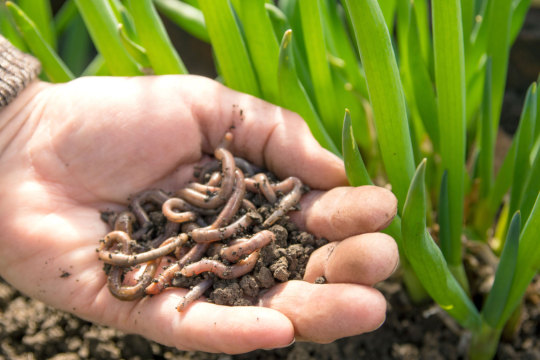
Ground beetles: Ground beetles are found in your garden's soil. They live soil beneath mulches, around compost piles or the sheltered areas. And they have 11/2 inches long colorful, shiny and hard-shelled. Ground beetles are beneficial for our garden to make it an organic garden. Some of them harmful for our garden because they eat helpful insects. Ground beetles eat insects that move, including slugs, earthworms, snails, cabbage beetles.
Praying mantids: These bugs have large eyes and swiveling head and mantids entertain us. When mantids are sitting, they make praying posture. Most mantids are 5-8 centimeters in length. Mantids flying from place to place and they move slowly and prefer to walk of branches and leaves of the plant. Mantids have two large eyes and they can see all around there, and they have pairs of legs. The first pair of legs distinctively forward and allow mantids to catch insects or other preys. Typically they are green or brown color. Mantids eat insects and other small victims sometimes they feed beneficial insects. The life cycle of mantids has three stages: eggs, nymph, and adult. Female mantids lay 200 or more than 200 eggs. Eggs hatch and nymph grows day by day and changes into the adult. Mantids change their color according to plants.
Syrphid flies: Syrphid flies are beneficial flies for our garden. Syrphid flies also called hover flies. That flies play a major role in the plant. Without hover flies pollination of flowers or plants are impossible. Hoverflies include butterflies, bees, and other flies. They feed nectar from flowers or plants. They pollinate the plants in our garden. Syrphid flies also have four stages: eggs, pupa, larva or adult.
Spiders: Spiders are beneficial for the garden because they eat many insects which are harmful to our garden. They eat predatory mites, scale insects, wasps, caterpillars, aphids, mealybugs, moths, butterflies, plant bugs, thrips, leafhoppers, cucumber beetles, flies and other tiny insects. Spiders have eight legs, and it has only two body regions. A cephalothorax and abdomen along with wing, antenna, and unique mouthparts. The lifecycle of spider is that female spider laid the egg and after laying an egg, female spider dies. Spider spreads the web from their mouth to capture their meal.

Big-eyed bugs: Big-eyed bugs feed thrips, leafhoppers, aphids and other insects that would destroy our garden. They are the best friend of the backyard. They live longer than other bugs. Adults have black, brown or gray color. Big-eyed bugs have more tolerance insecticides than other bugs.
Damsel bugs: That bugs eat aphids, small caterpillars, thrips, leafhoppers and other pesky pests. Damsel bugs found in the vegetable garden. These bugs no damage the plants. You can collect them and release them from the backyard. Damsel bugs have gray or brown color. They have long, narrow head with 3/8 to ½ inches long elongated bodies. They have angled antennae and have four wings on their back when they fold their wings that make X-mark on their back. Damsel bugs very quick moving prey. Damsel prey fly when they feel disturbed.
The life cycle of damsel bugs is different than another prey. Damsel females' lay their eggs in plant tissues and their eggs hatch in one week. Damsel nymphs begin eating immediately. development of nymphs for 3 to 4 weeks then molt to adult.There are many generations of damsel bugs according to the season.
It's important to survive your garden from bag bugs. Bad bugs destroy the garden. Now we will discuss bad bugs of garden
Aphids: Aphids are small, soft-bodied bugs. They have pink, green and black color. They feed leaves, buds, shoots, and flowers. They are the big cause of distortion.
Birch leaf minors: It is a flat look larva, and adult sawfly has black color. They feed inside of foliage, which turns the leaves into brown color. They found on birch trees.

Gypsy moth: It is a black, brown or red color larva. They feed roots of plants and trees. They will destroy the plants.
Colorado potato beetle: They have reddish orange and yellowish, black and orange colored strips. They feed potato, tomato, eggplants. They eat the veins of the leaf.
Crucifer flea beetle: They are metallic blue-black colored beetles. They feed on leaves and leaving shot-hole appearance.
Read Also: Money Saving Gardening Tips
0 notes